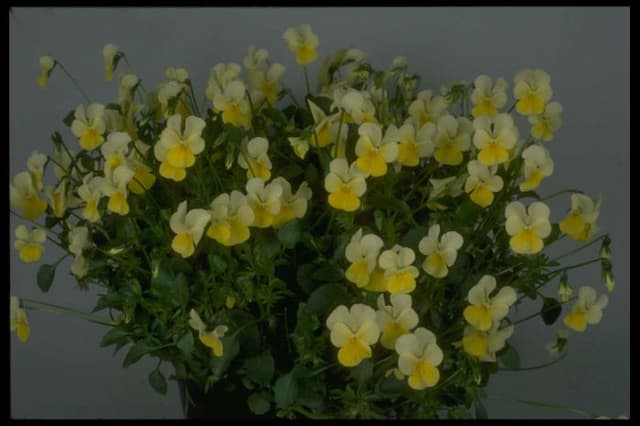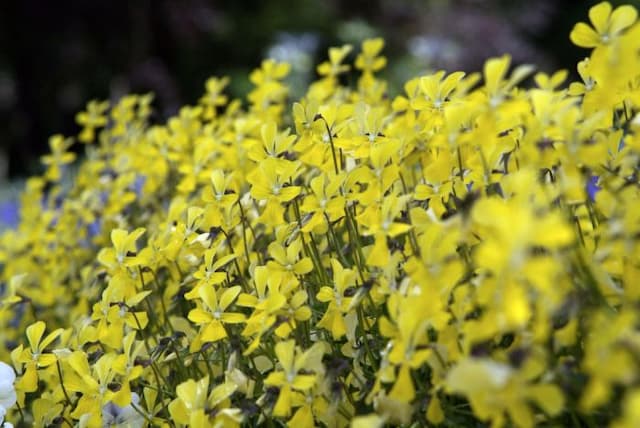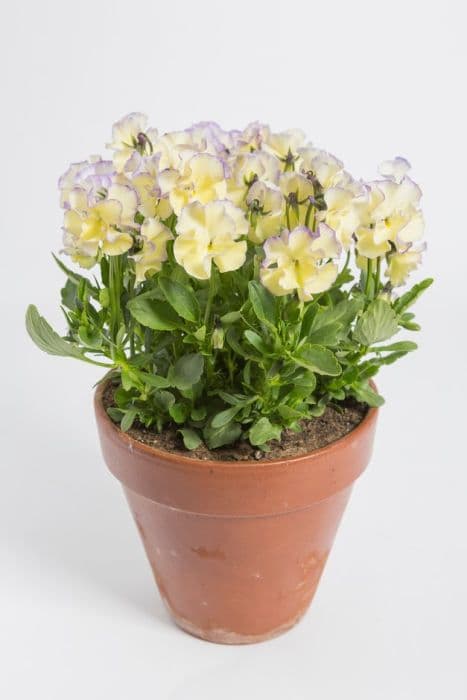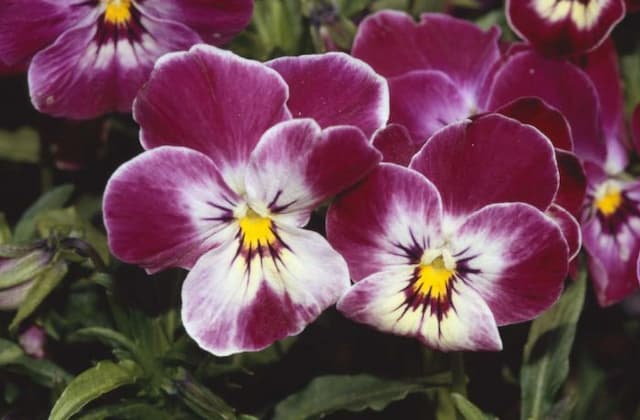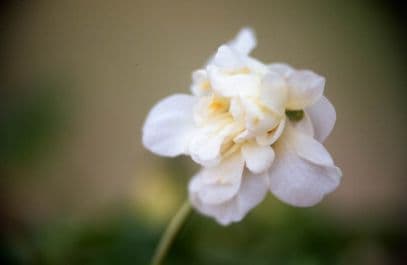Stonecrop 'Autumn Joy' Sedum spectabile 'Autumn Joy'


ABOUT
Stonecrop 'Autumn Joy' (Sedum 'Autumn Joy') is a popular perennial plant that grows in a compact clump formation. It typically reaches a height of about 1 to 2 feet and spreads to a width of about 1.5 to 2 feet .
The plant features succulent, fleshy leaves that are green and thick, adding a unique texture to the landscape. During its blooming season, which occurs in late summer to early fall, it produces large flower heads that can reach a diameter of 3 to 5 inches, composed of tiny star-shaped flowers in shades of pink to coppery-red. T
he flowers gradually change color as they age, transitioning from pink to a rich, deep red, and eventually developing a dark, rusty hue in the winter months.
Stonecrop 'Autumn Joy' is highly valued for its ability to attract pollinators and its ability to provide long-lasting interest in the garden, making it a popular choice among gardeners and landscapers.
About this plant
 Names
NamesFamily
Crassulaceae
Synonyms
Autumn Joy, Stonecrop 'Herbstfreude', Showy stonecrop, Iceplant, Butterfly stonecrop
Common names
Hylotelephium spectabile, Sedum spectabile, Sedum telephium var. kirinense, Sedum spectabile 'Herbstfreude', Sedum 'Indian Chief', Sedum 'Autumn Joy', Hylotelephium spectabile 'Indian Chief', Sedum spectabile 'Autumn Joy', Sedum spectabile 'Indian Chief', Sedum (Herbstfreude Group) 'Herbstfreude', Sedum Autumn Joy
 Toxicity
ToxicityTo humans
Stonecrop 'Autumn Joy' is generally considered non-toxic to humans when ingested in small quantities. However, it is always advisable to avoid consuming plants that are primarily grown for ornamental purposes unless confirmed safe by reliable sources.
If ingested in larger quantities, it may cause mild stomach upset or gastrointestinal discomfort. It's recommended to contact a medical professional or poison control center if any adverse reactions occur.To pets
Stonecrop 'Autumn Joy' is generally considered non-toxic to most animals, including cats, dogs, and horses. However, it's always a good practice to prevent animals from consuming large quantities of any plant material, as excessive ingestion can lead to digestive issues.
If an animal consumes a significant amount of Stonecrop 'Autumn Joy' or shows signs of illness after ingestion, it's best to consult a veterinarian for guidance and support.
 Characteristics
CharacteristicsLife cycle
Perennials
Foliage type
Deciduous
Color of leaves
Green
Flower color
Pink
Height
Up to 2 feet
Spread
Up to 2 feet
Plant type
Herb
Hardiness zones
2
Native area
Europe, Asia, and North America
Benefits
 General Benefits
General BenefitsOrnamental Value: Stonecrop 'Autumn Joy' is highly valued for its attractive appearance, with its fleshy leaves and large clusters of flowers. It adds visual interest and texture to garden beds, borders, and containers.
Long Blooming Season: This variety of Stonecrop blooms in late summer to early fall, providing a vibrant display of pink to coppery-red flowers. The flowers gradually change color, adding extended visual interest to the garden.
Drought Tolerance: Stonecrop 'Autumn Joy' is well-adapted to dry conditions and exhibits excellent drought tolerance. It can thrive in areas with limited water availability and is a suitable choice for xeriscaping or water-wise gardens.
Low Maintenance: It is a relatively low-maintenance plant that requires minimal care once established. Stonecrop 'Autumn Joy' is known for its ability to withstand neglect, making it suitable for busy gardeners or those looking for low-maintenance landscaping options.
Attracts Pollinators: The flowers of Stonecrop 'Autumn Joy' are a valuable nectar source for pollinators, including bees, butterflies, and other beneficial insects. Planting it can help support local pollinator populations and promote biodiversity in the garden.
Erosion Control: With its dense growth habit and extensive root system, Stonecrop 'Autumn Joy' can help stabilize soil and control erosion on slopes or embankments. Its ability to thrive in various soil conditions makes it a useful plant for erosion-prone areas.
Winter Interest: Even during the winter months, Stonecrop 'Autumn Joy' adds aesthetic appeal to the garden. The dried flower heads and foliage can provide visual interest and texture, especially when covered with frost or snow. Medical Properties
Medical PropertiesStonecrop 'Autumn Joy' is not typically recognized for significant medical properties or traditional medicinal uses.
 Air-purifying Qualities
Air-purifying QualitiesStonecrop 'Autumn Joy' is primarily grown for its ornamental value and is not widely recognized for its air purifying qualities.
 Other Uses
Other UsesButterfly Friendly Gardens: Stonecrop 'Autumn Joy' is a popular choice for butterfly-friendly gardens. The nectar-rich flowers of this plant attract butterflies and provide a valuable food source for them. By incorporating Stonecrop 'Autumn Joy' into your garden, you can create an inviting habitat that supports butterfly populations and promotes biodiversity.
Green Roofs: Stonecrop 'Autumn Joy' is well-suited for green roof installations. Its ability to withstand drought, thrive in shallow soil, and provide visual interest makes it an ideal plant for covering rooftops and creating sustainable green spaces. The fleshy leaves and drought tolerance of Stonecrop 'Autumn Joy' enable it to withstand the harsh conditions often found on rooftops.
Rock Gardens: Stonecrop 'Autumn Joy' is commonly used in rock gardens due to its ability to thrive in rocky or gravelly soil. Its low-growing habit and attractive foliage make it a suitable choice for adding texture and color to rocky landscapes or dry garden areas.
Living Walls and Vertical Gardens: Stonecrop 'Autumn Joy' can be utilized in living walls or vertical gardens, where plants are grown vertically on structures or walls. Its ability to tolerate low soil volume and its trailing growth habit make it suitable for vertical gardening applications, adding visual interest to vertical spaces.
Erosion Control: Stonecrop 'Autumn Joy' can be employed for erosion control on slopes or embankments. Its dense growth and extensive root system help stabilize soil, preventing erosion and promoting soil conservation.
Cut Flower Arrangements: The long-lasting flowers of Stonecrop 'Autumn Joy' make it a unique addition to cut flower arrangements. The large clusters of star-shaped blooms can be used fresh or dried, adding a touch of color and texture to floral displays.
Interesting Facts
 Feng Shui
Feng ShuiIn Feng Shui, Stonecrop 'Autumn Joy' can be used to bring the energy of earth and stability to a space. It is often recommended to place Stonecrop 'Autumn Joy' in the southwest or northeast areas of the garden or home, as these directions are associated with the Earth element. The plant's rounded, fleshy leaves and grounded energy can help create a sense of balance and harmony in the surroundings.
 Zodiac Sign Compitability
Zodiac Sign CompitabilityIn astrology, the compatibility of plants with specific zodiac signs is not a widely recognized or established practice.
 Plant Symbolism
Plant SymbolismStonecrop 'Autumn Joy' carries various symbolic meanings, including resilience, strength, and adaptability. Its ability to thrive in different conditions, including dry and rocky environments, represents its resilience and endurance. The plant's late-season blooms and changing colors symbolize transitions, growth, and the beauty found in impermanence. Additionally, Stonecrop 'Autumn Joy' is often associated with the qualities of grounding, stability, and harmony in natural settings.
 Water
WaterStonecrop 'Autumn Joy' is a drought-tolerant plant that thrives in well-draining soil.
It is important to avoid overwatering, as excessive moisture can lead to root rot. Water the plant deeply but infrequently, allowing the soil to dry out between watering sessions. During hot, dry periods, watering once every 1-2 weeks should be sufficient. Adjust the frequency based on the specific conditions of your garden, such as temperature, humidity, and rainfall. Light
LightStonecrop 'Autumn Joy' prefers full sun to partial shade.
It thrives in bright sunlight and requires at least 6 hours of direct sunlight each day to maintain its compact growth habit and promote optimal flowering. However, it can tolerate some light shade, particularly in hot climates, as long as it still receives sufficient sunlight. Place the plant in a location that receives ample sunlight to ensure its health and vitality. Temperature
TemperatureStonecrop 'Autumn Joy' is a hardy plant that can withstand a wide range of temperatures. It is well-adapted to temperate climates and can survive in USDA hardiness zones 3 to 9.
The plant can tolerate both heat and cold, withstanding temperatures as low as -30°F (-34°C) in winter and thriving in temperatures up to 90°F (32°C) during the summer months.
Stonecrop 'Autumn Joy' is known for its ability to endure harsh conditions, making it suitable for various regions and climates. Pruning
PruningStonecrop 'Autumn Joy' typically doesn't require extensive pruning. However, you can trim back the plant in early spring to remove any dead or damaged stems and promote a more compact form. Additionally, if the plant becomes leggy or overgrown, you can cut it back by about one-third of its height in early summer to encourage branching and a bushier appearance. Use clean and sharp pruning shears to make clean cuts, and ensure to remove any debris from the plant after pruning.
 Cleaning
CleaningNot needed
 Soil
SoilStonecrop 'Autumn Joy' prefers well-draining soil that is not overly rich or heavy. A sandy or loamy soil with good drainage is ideal for this plant. It thrives in soil that is moderately fertile and has a pH level ranging from slightly acidic to slightly alkaline.
A pH level between 6.0 and 7.5 is generally suitable for Stonecrop 'Autumn Joy'. If your soil tends to be heavy or compacted, you can improve drainage and aeration by adding organic matter, such as compost or well-rotted manure, to the soil. Repotting
RepottingGrown only in the open ground, so the plant does not require transplanting.
 Humidity & Misting
Humidity & MistingStonecrop 'Autumn Joy' is adaptable to a range of humidity levels and can tolerate both dry and moderately humid conditions. It is well-suited to dry climates and can withstand lower humidity levels.
However, it is important to note that good air circulation is crucial to prevent fungal diseases, especially in more humid environments. Providing adequate spacing between plants and ensuring proper ventilation can help prevent excessive humidity around the foliage. Avoid overwatering and allow the soil to dry out between waterings to maintain a balanced level of moisture. Suitable locations
Suitable locationsIndoor
Not growing
Outdoor
Cultivated all over the world in the right climate.
Hardiness zone
3-9 USDA
 Life cycle
Life cyclePlanting: Stonecrop 'Autumn Joy' can be planted in the garden or containers during the spring or fall months. In temperate climates, planting can occur from April to June or from September to October. Ensure the soil is well-draining, and place the plant in a location that receives ample sunlight.
Growth: After planting, Stonecrop 'Autumn Joy' will start its growth phase. In the first few weeks, the plant will establish its roots and begin developing new foliage. Growth typically continues throughout the summer months, with the plant gradually increasing in size and forming dense, succulent leaves.
Flowering: Stonecrop 'Autumn Joy' produces its distinctive flower clusters in late summer or early fall, typically starting around August or September. The flowers emerge in shades of pale pink and gradually deepen to a rich, coppery hue. The blooming period can last for several weeks, providing a beautiful display of color in the garden.
Harvest: Stonecrop 'Autumn Joy' is not typically grown for harvest purposes. However, if you wish to use the dried flower heads in floral arrangements or crafts, you can collect them after the blooming period. Harvesting can be done in late fall or early winter when the flower heads have dried and retained their shape and color.
Dormancy: During the winter months, Stonecrop 'Autumn Joy' enters a dormant phase. The plant's growth slows down, and the foliage may change color, turning bronze or reddish. It is essential to protect the plant from extreme cold temperatures or excessive moisture during this period to prevent damage. The dormant phase continues until the following spring when the plant begins its growth cycle again. Propogation
PropogationPropogation time
Spring - fall
Division: Division is a common and effective way to propagate Stonecrop 'Autumn Joy.' It involves separating the plant into smaller sections, each with their own roots and shoots. The best time to divide Stonecrop 'Autumn Joy' is in the early spring, just as new growth is beginning. This is typically done in March or April when the plant is emerging from dormancy. Divide the plant carefully, ensuring each division has enough roots and foliage to establish itself.
Stem Cuttings: Stem cuttings are another propagation method for Stonecrop 'Autumn Joy.' It involves taking cuttings from the plant and encouraging them to develop roots. The best time to take stem cuttings is during the active growing season, which is typically in late spring or early summer. Choose healthy stems and cut them into 3-4 inch sections. Remove the lower leaves and insert the cuttings into a well-draining potting mix. Keep the soil moist, and roots should develop within a few weeks.
Leaf Cuttings: Stonecrop 'Autumn Joy' can also be propagated from leaf cuttings. This method involves taking individual leaves from the plant and allowing them to develop new roots and shoots. The ideal time for leaf cuttings is during the active growing season, similar to stem cuttings, in late spring or early summer. Select healthy leaves and gently remove them from the stem. Place the leaves on a well-draining potting mix and lightly press them into the soil. Mist the leaves occasionally to maintain humidity and keep the soil slightly moist. New plantlets should emerge from the base of the leaves within a few weeks.
 Pests
PestsMealybug, Aphid, Slugs and snails
 Diseases
DiseasesRoot Rot, Powdery mildew, Leaf spot
